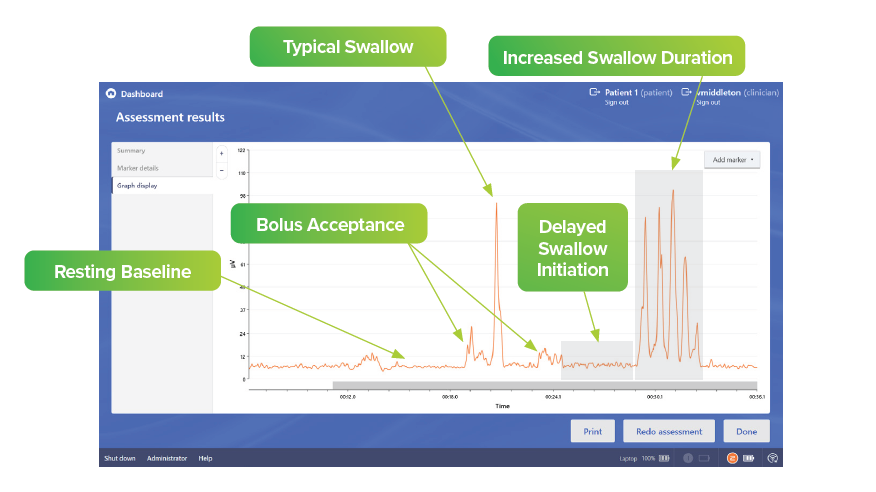Muscle strength decline is associated with normal aging and may be accelerated by illness, disease, or injury. Decreased physical activity resulting from COVID-19 mitigation efforts is exacerbating the incidence of muscle disuse atrophy in older adults. Strength declines may lead to functional and mobility deficits with increased risk of falls, injury, or death. According to the CDC, each year three million adults are treated in emergency departments for injuries related to falls. By 2030 fall deaths are anticipated to rise to seven per hour. Accurate assessment of strength using validated tests and objective measures is crucial to creating an appropriate treatment plan and achieving outcomes that reduce fall risk.
Objective Tests and Measures: Strength Assessment and Treatment Guidance
Topics: Fall Prevention & Balance, Clinical Tip, Cardiopulmonary
Topics: Industry News
Topics: Industry News
Speech-Language Pathologist and the Use of Advanced Technology in Cardiopulmonary and Airway Disorders
Speech-language pathologists (SLPs) are commonly involved in the rehabilitation of patients with cardiopulmonary disorders. Patients hospitalized with respiratory diseases such as COPD and heart failure (HF) are identified as at risk for development of oropharyngeal dysphagia. Additionally, patients who experience prolonged endotracheal intubation have an increased risk of developing dysphagia. (Malandraki et al., 2016) This is often seen in patients hospitalized for COVID-19.
Topics: Dysphagia, Cardiopulmonary
Decreasing Pain and Improving Functional Mobility Using Electrical Stimulation, Ultrasound, and Exercise
Patient Information: Female, Age 77
Diagnosis: Left Knee Pain
History: This woman, a long-term care resident of a skilled nursing facility, was referred to therapy due to knee pain and a decline in functional activity and ambulation. Prior to this recent decline, she was independent with ambulation throughout the facility.
Topics: Pain Management, Patient Success Story
Cycling Exercise in Rehabilitation to Improve Coordination and Normalize Muscle Tone
Physical and occupational therapists treat many individuals who present with impaired coordination, motor control, balance and tone. These individuals may have a wide range of diagnoses, from neurologically involved, such as cerebral vascular accident (CVA) and Parkinson’s disease, to orthopedic involvement such as post-total knee replacement (TKR). The common goal of improving functional mobility and outcomes may be achieved by the addition of research-supported cycling and biophysical agents.
Topics: Clinical Tip, Cardiopulmonary, Neuro Rehab
Patient Information: Female, Age 72
Diagnosis: Cardiac Arrest / Pulmonary Embolism
History: This woman was referred to a skilled nursing facility for rehabilitation services due to severe weakness and debility following hospitalization. She had a pulmonary embolism (blood clot in the lungs) which required intubation and life support with extracorporeal membrane oxygen – ECMO (blood pumped outside the body to a heart and lung machine to remove carbon dioxide and send oxygenated blood back to the body). Prior to hospitalization, she lived at home and was independent with all mobility and self-care.
Topics: Patient Success Story, Cardiopulmonary
The rehabilitation of patients with and recovering from COVID-19 is evolving and will be an integral part of therapy for the foreseeable future. The American Physical Therapy Association (APTA) developed a task force representing all academies and sections to identify core outcome measures to be used with all patients diagnosed with COVID-19 throughout care, across all settings. These outcome measures are to be used with patients having goals associated with five constructs; function, strength, endurance, cognition, and quality of life. (APTA, 2020)
Topics: Clinical Tip, Cardiopulmonary
Decreasing Pain and Improving Functional Independence Using Electrical Stimulation and Exercise
Patient Information: Female, Age 76
Diagnosis: Chronic Heart Failure / Generalized Muscle Weakness / Shoulder Pain
History: This woman was admitted to the hospital to address multiple medical issues. Following hospitalization, she was referred to a skilled nursing facility for rehabilitation to address her limitations in strength and mobility, with a goal to return home alone at her prior level of function, independent with all mobility.
Topics: Patient Success Story
Improving Strength and Functional Mobility Using Electrical Stimulation and Exercise
Patient Information: Female, Age 68
Diagnosis: Respiratory Failure
History: This woman was referred to a skilled nursing facility due to severe deconditioning following a two-month hospitalization for pneumonia, during which she experienced respiratory arrest and required ventilation by tracheostomy intubation (surgical procedure inserting a breathing tube through the trachea to restore breathing).
Topics: Patient Success Story, Cardiopulmonary






